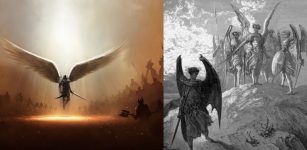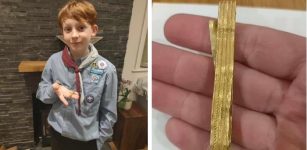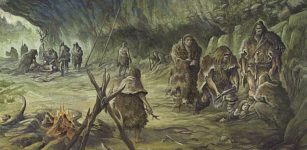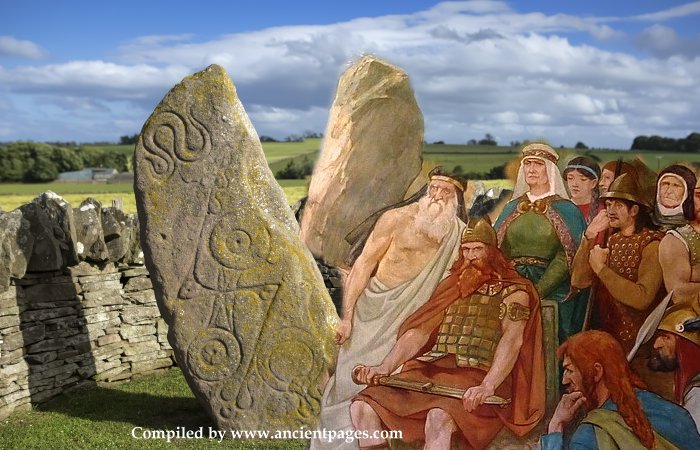Picts: Facts And History About Mysterious People Of Northern Scotland
Ellen Lloyd - AncientPages.com - Not much is known about the mysterious Picts, yet they played a vital role in the history of Scotland. These brave and determined people repelled the conquests of Romans and Angles and won one of the most important battles in Scottish history.
The Picts used mysterious symbols that still haven’t been properly deciphered, and their enigmatic language is now extinct. In this article, we take an in-depth look at the people of Northern Scotland and examine facts and history about the Picts.
The true identity of the Picts remains unknown
Today, it is generally accepted that the Picts were not a race of one people but several tribes that united. They were driven by political motivations and a need to ally against common enemies.
According to the Collins Encyclopedia of Scotland, "the Picts did not 'arrive' - in a sense they had always been there, for they were the descendants of the first people to inhabit what eventually became Scotland". The Picts are often described as the descendants of the indigenous Iron Age people of northern Scotland and it is thought that they came originally from Scandinavia as a cohesive group. Since they left no written record of their history, what is known of them comes from later Roman and Scottish writers and from images the Picts themselves carved on stones.

Generations of historians have questioned why the Picts seemed to disappear from history after fighting the Romans and Vikings.
The earliest surviving mention of the Picts dates from AD297, and it comes from the Roman writer Eumenius, who referred to the tribes of Northern Britain as "Picti" ("the painted ones"), presumably because of their habit of painting their bodies with dye. The Picts are often said to have tattooed themselves, but evidence for this is limited. The Irish called the Picts the ‘Cruithne’.
The Picts’ mysterious language and symbols
The Picts’ language is a mystery, and the meaning of the symbols and stones they left remains an enigma. The language the Picts spoke has been lost, but more than 250 stones with Pictish symbols survived, which can give us a better understanding of the Picts. Some Pictish stones have written inscriptions. Pictish letters - called 'ogam' - had no curves, so they were well suited for carving on stone.

The Aberlemno Serpent Stone, Class I Pictish stone with Pictish symbols, showing (top to bottom) the serpent, the double disc and Z-rod and the mirror and comb. Image credit: Wikipedia
Early symbol stones were rough, undressed boulders; later stones were carefully shaped and dressed.
The earliest stones show incised animals and geometric shapes unique to the Pictish culture, like the crescent and v-rod, the double-disc, and the serpent and z-rod.
Later, stones were sculpted in relief, allowing the elaborate designs to stand out from the background. Designs include incised Christian crosses and biblical scenes.

The presence of two sets of symbols on a single stone is considered a very unusual feature relative to the corpus of symbol-bearing stones. Credits: Aberdeenshire Council
The Dandaleith Stone is a rare symbol stone of the Picts. Scientists have long tried to decipher this remarkable and unique artifact, and with a bit of luck, they may unlock the secrets of the Dandaleith Stone in the near future.
Little is known about the Picts’ beliefs, society, and daily life
Since the Picts did not leave any written records, it’s very difficult to get a clear insight into their lives, beliefs, or society. The information historians possess originates from second-hand anecdotal evidence, lifted from the various historical writers who recorded their own, possibly biased, impressions of the Pictish people.

Dun Carloway broch, Lewis, Scotland. Credit: Public Domain
However, historians have established that Picts were farmers living in small communities. Cattle and horses were an obvious sign of wealth and prestige. The early Picts are associated with piracy and raiding along the coasts of Roman Britain. Even in the Late Middle Ages, the line between traders and pirates was unclear, so Pictish pirates were probably merchants on other occasions.
Archaeologists have discovered evidence of watermills constructed by the Picts. The Brochs are also associated with the Picts. The word broch is derived from Lowland Scots 'brough', meaning (among other things) fort. The purpose of the Brochs is not entirely clear, but these roundhouse buildings have been found throughout Atlantic Scotland. Some historians and archaeologists think the Brochs were defensive military structures. Others have suggested the buildings were farmhouses.
The Picts lost the battle but won the war against the Romans
What are some of the significant and most important battles fought by the Picts?
A hand-colored version of Theodor de Bry’s (1528 - 1598) engraving of a Pict woman. Credit: Public Domain
Rome’s first incursions into Britain were by Julius Caesar in 55 and 54 BCE but began effectively in 43 BCE under Emperor Claudius.
In 79/80 CE, Julius Agricola, the Roman governor of Britain, invaded Scotland and pressed on to a line between the rivers Clyde and Forth by 82 CE.
Agricola faced the Picts with 11,000 soldiers of the 9th Legion and defeated them. The Picts attacked in the same form they would have grown accustomed to in tribal warfare, while the Romans held their position in the strict formation and repulsed the charge, then counter-attacked. Although the Romans won the battle, allegedly killing 10,000 Pictish warriors, they could not capitalize on this victory. Unlike other nations that the Romans invaded, the northern reaches of Britain had no central cities that could be conquered. The Picts held their territory against the invading Romans in several engagements.
They were defeated in battle, but they won the war. Scotland holds the distinction of never falling to the invading armies of Rome, even though the Romans attempted conquest numerous times.
The Picts were unconquerable because they presented the Romans with a new paradigm that Rome could not adapt to. The Roman legions had not yet encountered this kind of guerilla warfare.
In 122 CE, the emperor Hadrian ordered the construction of his famous wall, which ran for 73 miles (120 km), sometimes at a height of 15 feet, from coast to coast. In 142 CE, the Antonine Wall was constructed further north under the reign of Antoninus Pius. The Romans considered the Picts barbarians, and to the Picts, the Romans were an invading force that must be defeated,
The walls served as psychological as well as physical barriers. However, these walls did not discourage Pictish raids.
When the Romans left Britain in 410 CE, the Picts still lived as they always had in the regions north of the wall. Whatever effect the Roman presence may have had on them is unknown. Still, the carvings the Picts left on their standing stones show no major differences in lifestyle from before the arrival of Rome to after the departure of the legions.
The Battle of Dun Nechtain - one of the most decisive battles in Scottish history
The Picts were courageous and determined. They repelled the conquests of both Romans and Angles. The Picts took part in one of the most decisive battles in Scottish history - the Battle of Dun Nechtain (Dunnichen).

Pictish symbol stone depicting what was once generally accepted as the Battle of Dun Nechtain. This image is a crop of a photograph of the Pictish stone in the churchyard at Aberlemno Parish Church (the stone is sometimes known as Aberlemno II). Image credit: Wikipedia
The Battle of Dun Nechtain is one of the best-recorded events in the history of Scotland.
On 20 May AD 685, a force of Northumbrians under King Ecgfrith faced King Bridei’s Picts at the Battle of Dunnichen. The Northumbrian Angles were annihilated.
The Venerable Bede wrote of King Ecgfrith:
… rashly leading his army to ravage the province of the Picts … the enemy made show as if they fled, and the king was drawn into the narrows of inaccessible mountains, and slain, with the greatest part of his forces Bede. (The Ecclesiastical History of the English People, c AD 731)
Scotland might never have existed if the Picts had lost the Battle of Dun Nechtain. It was simply a disaster for the Angles of Northumbria - ending their domination of Scotland.
The Picts created a true north-south divide on the British Isles, only to disappear from history by the end of the first millennium - swallowed whole by the history of another group, the Gaels. Together, they created the Kingdom of Alba.
Updated on Septermber 5, 2024
Written by - Ellen Lloyd – AncientPages.com
Copyright © AncientPages.com All rights reserved. This material may not be published, broadcast, rewritten or redistributed in whole or part without the express written permission of AncientPages.com
Expand for referencesMore From Ancient Pages
-
 On This Day In History: Antarctic Explorer Lawrence “Titus” Oates Born – On Mar 17, 1880
News | Mar 17, 2017
On This Day In History: Antarctic Explorer Lawrence “Titus” Oates Born – On Mar 17, 1880
News | Mar 17, 2017 -
 Mireuksa Pagoda: Largest And One Of The Oldest Of Korean Pagodas
Archaeology | Jan 1, 2016
Mireuksa Pagoda: Largest And One Of The Oldest Of Korean Pagodas
Archaeology | Jan 1, 2016 -
 Could Neanderthals Meditate? Scientists Investigate
Archaeology | Jun 30, 2022
Could Neanderthals Meditate? Scientists Investigate
Archaeology | Jun 30, 2022 -
 Thousands Of Roman Coins Found Across Europe Are Fake – Archaeologists Say
Archaeology | Jul 9, 2019
Thousands Of Roman Coins Found Across Europe Are Fake – Archaeologists Say
Archaeology | Jul 9, 2019 -
 On This Day In History: Maltese Rebellion Took Place – On Sep 8, 1775
News | Sep 8, 2016
On This Day In History: Maltese Rebellion Took Place – On Sep 8, 1775
News | Sep 8, 2016 -
 8,000-Year-Old Nephrite ‘Frog-Like’ Swastika In Bulgaria’s Neolithic Settlement – Unearthed
Archaeology | Dec 8, 2015
8,000-Year-Old Nephrite ‘Frog-Like’ Swastika In Bulgaria’s Neolithic Settlement – Unearthed
Archaeology | Dec 8, 2015 -
 DNA Unravels Mysteries Of The Crannogs, Ancient Artificial Islands Older Than Stonehenge
Archaeology | Oct 10, 2022
DNA Unravels Mysteries Of The Crannogs, Ancient Artificial Islands Older Than Stonehenge
Archaeology | Oct 10, 2022 -
 What Is Pax Sinica?
Ancient History Facts | Apr 26, 2018
What Is Pax Sinica?
Ancient History Facts | Apr 26, 2018 -
 The Untold Story Of Mexico’s Ancient Giant Indians – Cunning Plan And The Evil Nation – Part 2
Ancient Mysteries | Sep 23, 2019
The Untold Story Of Mexico’s Ancient Giant Indians – Cunning Plan And The Evil Nation – Part 2
Ancient Mysteries | Sep 23, 2019 -
 Is ‘Someone’ Regularly Altering The Course Of History? – Is So How, Why And Who? Part 1
Ancient Mysteries | Nov 30, 2020
Is ‘Someone’ Regularly Altering The Course Of History? – Is So How, Why And Who? Part 1
Ancient Mysteries | Nov 30, 2020 -
 Fossilized Skulls Reveal Relatives Of Today’s Rhinos Had No Horn And Died Out 5 Million Years Ago
Fossils | Nov 2, 2023
Fossilized Skulls Reveal Relatives Of Today’s Rhinos Had No Horn And Died Out 5 Million Years Ago
Fossils | Nov 2, 2023 -
 1.5-Million-Year-Old Hand Axes And Hundreds Of Ancient Artifacts Found In The Iraqi Desert
Human Beginnings | Jan 31, 2025
1.5-Million-Year-Old Hand Axes And Hundreds Of Ancient Artifacts Found In The Iraqi Desert
Human Beginnings | Jan 31, 2025 -
 Robots Guarded Buddha’s Relics In Ancient India – Legend Tells
Featured Stories | Jun 28, 2019
Robots Guarded Buddha’s Relics In Ancient India – Legend Tells
Featured Stories | Jun 28, 2019 -
 Underwater Jars Reveal Roman Period Winemaking Practices
Archaeology | Jun 30, 2022
Underwater Jars Reveal Roman Period Winemaking Practices
Archaeology | Jun 30, 2022 -
 Mystery Of The Watchers And Book Of Enoch – Fallen Angels And Their Secret Knowledge
Biblical Mysteries | Oct 27, 2017
Mystery Of The Watchers And Book Of Enoch – Fallen Angels And Their Secret Knowledge
Biblical Mysteries | Oct 27, 2017 -
 Wari Culture: Ancient Astronomical Observatory Excavated In Cusco, Peru
Archaeology | Dec 20, 2017
Wari Culture: Ancient Astronomical Observatory Excavated In Cusco, Peru
Archaeology | Dec 20, 2017 -
 Young Boy Discovers Rare Ancient Roman Treasure In Sussex, UK
Archaeology | Apr 15, 2024
Young Boy Discovers Rare Ancient Roman Treasure In Sussex, UK
Archaeology | Apr 15, 2024 -
 Mystery Of The Lost Beverina Castle – Did Knights Templar Know Where It Was?
Ancient Mysteries | Jan 21, 2018
Mystery Of The Lost Beverina Castle – Did Knights Templar Know Where It Was?
Ancient Mysteries | Jan 21, 2018 -
 Unexplained Mystery Of Secret Knowledge And Extraordinary Sightings Hidden In An Author’s Book
Featured Stories | Nov 25, 2021
Unexplained Mystery Of Secret Knowledge And Extraordinary Sightings Hidden In An Author’s Book
Featured Stories | Nov 25, 2021 -
 Neanderthals Buried Their Dead – New Evidence
Archaeology | Dec 10, 2020
Neanderthals Buried Their Dead – New Evidence
Archaeology | Dec 10, 2020


